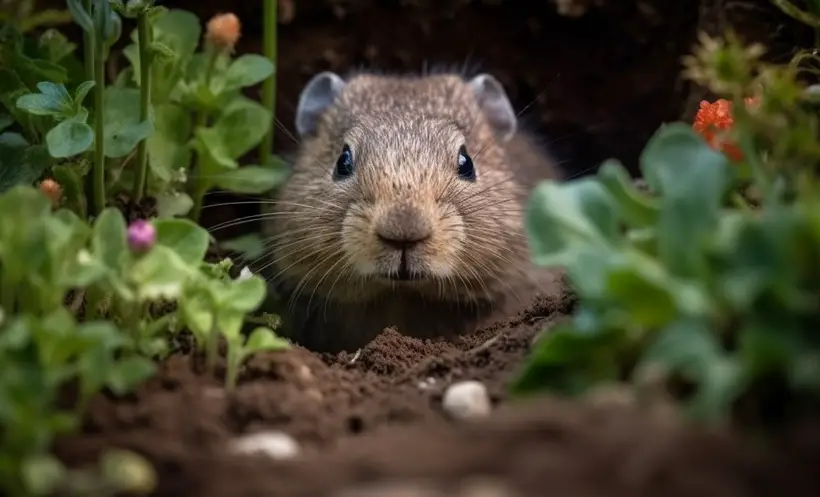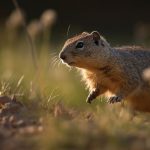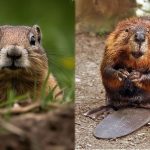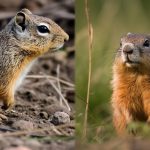How To Find Gopher Tunnels, Trapping & Removal Methods
If you have a garden or lawn, gophers can wreak havoc on your plants, flowers, or grass in very little time. These pests usually prune or clip plant roots as they dig their underground tunnels.
In addition, gophers may girdle and clip the bark of shrubs and trees. Even worse, their tunnels may lead to soil erosion, causing damage to the roots.
The good news? Many pest control methods exist to help you eliminate gophers from your beautiful garden. However, to effectively control these pests, you must locate their tunnels.
After all, other rodent species also dig tunnels almost similar to those of gophers. Therefore, you can easily mistake gophers’ burrow systems for other pests.
But how to find gopher tunnels? Well, locating gopher nests and their tunnels is easy by looking out for possible damage to plants and roots. You could also unearth the tunnels by looking for large soil mounds, damaged water lines, and utility cables.
Wait, it doesn’t stop there! So, stay right here to find out everything there is to know about identifying gopher tunnels.
Signs of Gopher Infestations
If you suspect that you have gopher infestations in your lawn or garden, below are some signs to watch out for.

Large Soil Mounds
Like other rodents, gophers usually create tunnels underground to forage for food. They prefer soil quality that is loose and sandy. And as they do this, they tend to leave behind mounds of dirt near the tunnel entrance.
But compared to dirt mounds left by other rodents like moles, gophers’ heaps are more enormous and crescent or fan-shaped. Conversely, mole dirt mounds are shorter and cone-shaped.
Damaged Plants
Another sign to watch out for is a plant or root damage. This is because these pests feed on vegetation. Therefore, they may attack the plants from their tunnels by eating the roots.
For small plants, gophers may pull the plants down into the tunnels. So, it would help if you also looked out for disappeared plants. Sometimes, these pests may forage above the ground and damage the leaves and tubers, creating bald spots in your garden.
Electrical Issues
Pocket gophers may severely damage any buried utility cables and communication lines. If they encounter the cables, they may chew through the wires like plants’ roots while burrowing.
Consequently, your garden lighting may experience intermittent problems like dimming and flickering. However, electrical issues alone cannot be a sign of gopher infestation. So, this sign must be accompanied by other signs like dirt mounds or plant damage.
Soil Erosion
Additionally, gophers can gnaw and damage plastic irrigation systems and water lines, especially those used for drip irrigation. This animal burrowing behavior may cause the water to be diverted through their tunnels, causing soil erosion.
As a result, you may notice Riverbend-like gullies through the ground and cracks in the soil.
How to Identify Gopher Activity Through Visual and Physical Cues?

- One way to identify gopher activity is the opening of the holes. If flesh dirt mounds block the hole, it means a gopher is inside and burrowing.
- However, the gopher may have already vacated if the holes are not plugged with the soil.
- Another way of identifying gopher activity is to look for groups of holes dug close to each other. Gophers typically dig small holes that they emerge from and feed on plants.
- Additionally, you may notice the plants yellowing, wilting, or experiencing stunted growth. This happens when the gophers feed on their roots from underground.
- More so, you may spot evidence of gopher’s gnaw marks on the bulbs or roots of plants that have been partially eaten.
Identifying Gopher Tunnels
Locating gopher tunnels can be daunting if you don’t know what to look for. So, below we will discuss the various gopher tunnels available.

Surface Runways
These are shallow lateral tunnels that gophers use to move between their burrow systems and feeding areas. Typically, there exist many lateral tunnels connecting to the main tunnel. These surface runways usually end in dirt mounds at the soil’s surface.
Unlike the main tunnel, gophers dig the surface runways closer to the soil surface instead of deeper underground. Therefore, they are usually visible as depressions or raised ridges from above the ground.
Deep Tunnels
These are the primary burrows that gophers utilize for storing food and nesting. They can be 4 to 18 inches deep from the ground with many surface runways. The food storage and nesting areas may be about 72 inches or 6 feet deep inside these deep tunnels.
Deep tunnels are broader, more permanent, and more complex than surface runways. This is because their job is to protect these garden pests from harsh weather conditions and predators.
How To Identify Gopher Tunnels Through Visual and Physical Cues?

Now that you know how to locate gopher tunnels, read on to discover how to identify their burrows.
Probing
This involves examining the gopher tunnels thoroughly using a probe. You can buy the probe tool online or from your local home improvement store. Alternatively, you can construct the device using a metal rod or a long PVC pipe.
To locate the deeper tunnels, here are the steps to follow:
Step 1: Probe into the soil about 6 to 12 inches deep away from the fresh mound. The probing should be from the side near the pile.
Step 2: Rotate the probe to enlarge the opening.
Step 3: Once the device enters the tunnel, it should suddenly drop about two inches. When this happens, keep poking the tunnel until you locate the primary burrow.
Soil Disturbance
As gophers dig their tunnels, they push excess soil to the surface, causing soil disturbance and creating huge dirt mounds. These mounds are usually visible in a garden.
Sometimes, gophers gnaw on underground water pipes or irrigation systems. When this happens, the water may be redirected to their tunnels, leading to soil erosion. As a result, you may notice exposed roots, gullies, and rills.
Gopher Damage Detection

Wondering how to detect gopher damage? Check out these gopher damage detection methods.
Damaged Plant Roots
Gophers primarily feed on plant structures like roots, bulbs, and tubers. They may clip or prune the plant’s roots. This gopher behavior causes the plants to die.
Feeding Behavior
The feeding behavior of gophers involves digging deep underground tunnels to forage for food. While burrowing, they usually dump mounds of fresh soil at the entrance of the tunnels. However, sometimes they may leave small piles of vegetation behind.
How to Use These Signs to Locate Gopher Tunnels?
If you understand plant physiology, you know they absorb water and minerals through the roots. If the roots are clipped or pruned by gophers, the plants may experience stunted growth and eventually die. In addition, you may observe large or small patches of dead grass on your lawn.

In the case of feeding behavior, the gophers will leave mounds of dirt around your garden due to digging. You will find the stacks where the soil is moist.
Gopher Trapping and Removal
Once you have confirmed gopher infestation in your garden, you must eliminate them. Here is how to do it.
Live Trapping
This method involves using a box trap with a bottom mesh and a door that closes from the inside. You only need to put the trap near the entrance of the gopher’s tunnel with peanut butter or lettuce as bait.
The bait should be near the end of the trap so the gopher can step on the trigger plate, causing the door to close.

Garden Fencing
You can also create an in-ground fence around your lawn or garden using welded metal mesh or mesh poultry wire. The fence must be buried at least 2-3 feet deep and 6-12 inches above the ground. This is to prevent gophers from pruning the roots.
Companion Planting
Additionally, you can grow natural repellent plants like lavender, daffodils, thyme, marigold, sage, castor bins, and alliums in your garden. Gophers dislike the smell and roots of these plants.
Natural Gopher Repellents
Alternatively, you could use natural pest repellents like castor and peppermint oils. These repellants have a strong smell that gophers hate. Also, castor oil has a laxative effect on gophers.
Flooding
After finding gopher burrows, you can flood them with water using a garden hose. This may force these pests to vacate the burrows.
Barn Owls
Barn owls are the biggest gophers’ predators and a natural pest control method. So, if you live in areas where barn owls thrive, you could put up nest boxes in your garden. This will encourage the owls to stay around, helping control gophers’ populations.
Contact a Professional
Lastly, you could contact a professional wildlife removal expert. These professionals have the knowledge of various wildlife management practices, equipment, and experience to safely trap and remove gophers from your yard.
How Does Locating Gopher Tunnels Help Improve the Effectiveness of Trapping and Removal Methods?
The key to effectively trapping and removing all gopher species is accurately locating their burrows. This is because gophers rarely revisit the surface runways. Therefore, putting traps in these lateral tunnels may not be as successful in removing gophers as in deep tunnels.

Additionally, locating the tunnels ensures you don’t place the traps on tunnels belonging to other rodents like moles.
If you’re wondering how to locate gopher tunnels on your property, there are a few key steps you can take. Once you’ve identified active tunnels, you might also be interested in learning more about gopher burrowing behavior. Our articles on how deep do gophers dig their tunnels and can you have a gopher as a pet can provide you with more information. The article on how deep do gophers dig their tunnels explores the various factors that influence gopher burrowing behavior, including soil type, moisture, and vegetation. Meanwhile, our article on can you have a gopher as a pet discusses the challenges and considerations involved in keeping a gopher as a pet. By understanding more about these fascinating rodents, you can develop a deeper appreciation for their role in the ecosystem and the challenges they can pose to homeowners.FAQs
Before we conclude, let’s check out some frequently asked queries regarding how to find gopher tunnels.
Q: What is the best time of day to search for gopher tunnels?
Experts recommend searching for the gopher tunnels early in the morning while the ground is damp. This is because gophers are active both during the day and at night.
Q: Can gophers damage underground utility lines and pipes?
Yes. Gophers’ burrowing activities may cause damage to utility lines and pipes buried underground. This behavior is typical when these pets are foraging for roots underground.
Q: How can you prevent gophers from re-infesting your garden or lawn after removal?
You could eliminate their food sources. If impossible, you could practice exclusion fencing or use natural repellent plants and oils. Different lawn maintenance practices like constantly irrigating the garden, may also discourage gophers from digging.
Conclusion
Identifying gopher tunnels is critical for effective garden pest control. The good news is that many visual and physical cues exist to help you identify gopher infestation. These include dirt mounds and damaged plants.
Even better, several methods of detecting gopher damage and trapping and removing these pests exist. For instance, you could use live traps, natural repellents, barn owls, or opt for wildlife management methods.
That said, effective pest control is only possible once you have located the gopher tunnels. This is because you could place the traps on other rodents’ tunnels. And in this case, the gophers will still be a nuisance in your garden.
Now, while there are many gopher trapping and removal methods, more research is needed to understand gophers’ wildlife behavior. More so, researchers need to concentrate on developing more natural control methods for these pests.




